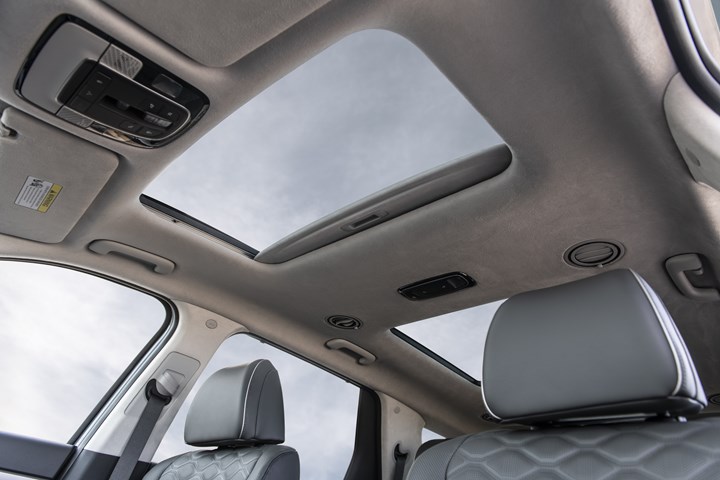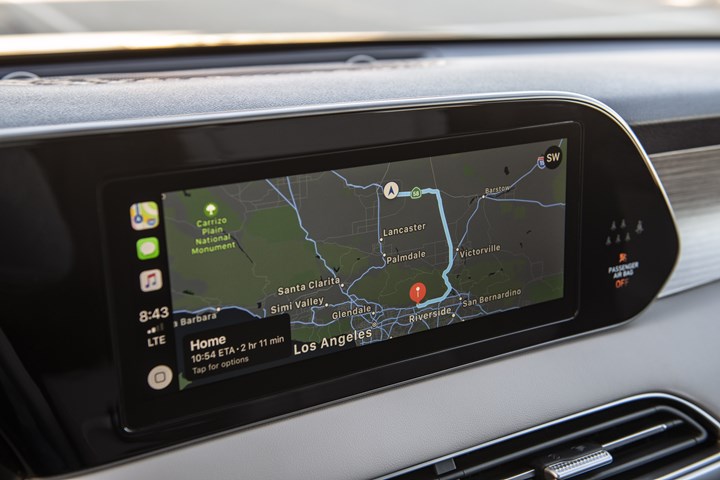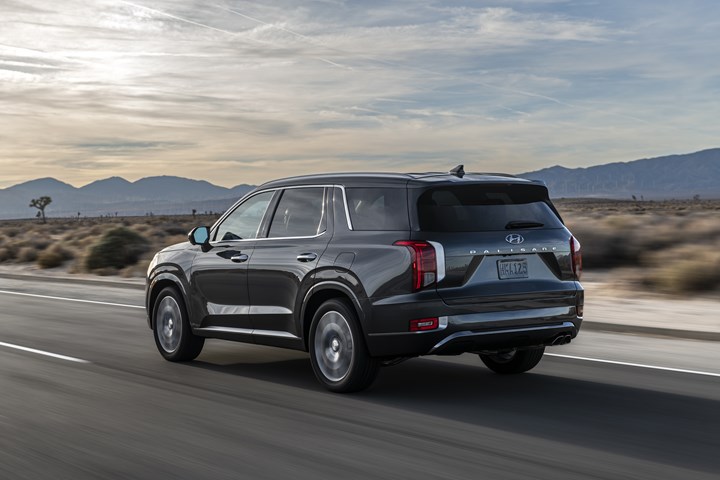Hyundai Palisade Brings the Space
The challenge is easy to state but the execution is hard to pull off: Create an all-new midsize sport utility that can more than hold its own against well-established competitors like the Ford Explorer, Honda Pilot and Toyota Highlander, and new ones like the Subaru Ascent and the Volkswagen Atlas. Introducing the Palisade.
#electronics #interior
During the past couple of years, the folks at Hyundai have been rather busy, with facelifts (Elantra, Sonata Hybrid, Tuscon), new versions of existing models (Santa Fe, Veloster), new variants (Veloster N, Elantra GT N) and completely new vehicles (Kona, Kona Electric, NEXO). While all of these have helped contribute to increased sales and transaction prices, the company recognizes, explains Brian Smith, Hyundai Motor America chief operating officer, that there was a need for Hyundai to do more to reach families with children. While automotive execs tend to spin things such that whatever they’re doing is right and good, Smith points to an “Avoider Study” conducted by Maritz that looks at how well various brands are doing when it comes to selling to people at various life stages. When it comes to families, Hyundai is at 16.2%, which puts it behind Toyota (17.5%), Ford (17.8%), Nissan (21.3%), Chevrolet (21.3%), Honda (22.1%), and Mazda (23.5%).
While Hyundai does have the Santa Fe XL that has a third row of seats, Smith says that of the 10 reasons why people avoided it, “lacked interior roominess” was at number 6.
Looking at the 10 reasons to buy a midsize SUV (ranging from Overall Quality at #1 and Overall Exterior Styling at #10), Passenger Seating Capacity came in at #4 and 3rd Row Seating Availability at #8, so when they set about developing a replacement for the Santa Fe XL, a vehicle that became the Palisade, going bigger and roomier were absolutely key.

The Hyundai Palisade features a striking exterior design that is in one sense characteristic of Hyundai design in that it has a bold execution yet doesn’t look like a larger version of something that’s already in the lineup.
So looking at the Santa Fe XL the designers and engineers worked to develop a vehicle that had increases in all of the size-based metrics, as in upping the seating capacity to 7/8 from 6/7, and making it 3 inches longer (196.1 inches), 3.6 inches wider (77.8 inches) and 2.4 inches taller (68.9 inches). The wheelbase is increased 4 inches (114.2 inches). And the cargo volume behind the first row is increased 6.4-ft3 (86.4-ft3), behind the second row 4.9-ft3 (45.8-ft3) and behind the third row 4.5-ft3 (18-ft3).
Of course, the Palisade wasn’t developed to compete with the Santa Fe XL but with products including the Toyota Highlander, Ford Explorer and Honda Pilot. And those dimensions make the Palisade far more competitive with those three from a size and space standpoint than the Santa Fe XL. This is absolutely important to the company because as Mike O’Brien, vice president, Product, Corporate and Digital Planning, points out data show that midsize SUVs are the second-hottest segment in the U.S. market right now (second only to subcompact SUVs), and while it is anticipated that sales in 2020 for the midsize models will hit 1,678,411 (they’re using information from IHS Markit), by 2025 that number is expected to reach 1,923,630. So Hyundai would like to go along with the growth and get its share of what is a crowded field that not only includes stalwarts like the previously mentioned, but newer entrants like the Volkswagen Atlas and the Subaru Ascent.
Advanced Steels Abounding
It wouldn’t be a new Hyundai if it didn’t have a significant use of advanced high-strength steels (AHSS) in its body structure. This is something that cannot be underestimated when it comes to producing a vehicle that has the level of torsional stiffness required to provide improved ride and handling (“Let the suspension do its work,” O’Brien says, explaining that if the body is flexing the suspension has to deal with that, too, which is not a good thing), as well as reduced noise, vibration and harshness (NVH). Realize that the Palisade is a large vehicle and one that, depending on trim level, has large sections of its roof stamping blanked out for purposes of sunroofs (i.e., there is a movable sunroof in the front and fixed glass sunroof toward the back). With the AHSS they engineered a sunroof reinforcement such that the torsional stiffness of the body-in-white of a Palisade with a sunroof is just 1.5% less than that of a vehicle with a normal roof.
The amount of advanced high strength steel in the Palisade is 59%. By way of comparison, the amount in the Santa Fe XL is 42% (which means that compared to the Santa Fe XL, the increase is about 40%, which goes to the point of “If it’s a new Hyundai, they’re rolling out the AHSS”). But O’Brien points out something that is notable vis-à-vis the competition. Ford has an all-new Explorer. How much AHSS is used? According to O’Brien, just 25% of the body-in-white.

Although this dual sunroof configuration provides the outside in, it is also a challenge from the point of view of structural rigidity, which Hyundai engineers addressed with advanced high-strength steels as well as the extensive use of adhesives.
There is also an extensive use of hot-stamped components, “for additional strength,” O’Brien says. There are 17 hot stamped components, with a predominant number going in the A- and B-pillar areas so as to provide front occupant protection (O’Brien: “From the beginning of the program we targeted NHTSA 5-star and IIHS Top Safety Pick+”).
Adhesives Advance
One of the engineering areas that Hyundai continues to excel in is its utilization of aerospace-grade structural adhesives in the build process. For the most part, vehicle structures (Hyundai’s or anyone else’s’) are assembled using resistance welds, or spot welds. (There are some limited uses of arc welding and laser welding, but these are very limited compared to spot welding.) The thing about spot welds is that they’re, well, discrete spots that are generally in a line. So there is a spot, a space, a spot, a space, and so on. The connections between the pieces of metal being joined are those spots.
But by applying a bead of structural adhesive in addition to the spot welds, there is a more robust connection that contributes to an improvement in stiffness and which helps assure that there is no slippage between the two joined surfaces.
As Hyundai comes out with new vehicles, the amount of adhesives applied goes up, and the Palisade structure is no exception, although it should be noted that this execution is nothing if not exceptional. That is, for the Santa Fe XL, which is basically the reference vehicle vis-à-vis the Palisade in the lineup, there are approximately 279 feet of adhesive used.
Yet for the Palisade the amount of adhesive is 489 feet. (Admittedly, the Palisade is a bigger vehicle, but that adhesive application number is primarily predicated on increasing the number of areas where the adhesive is utilized for the vehicle.)
However, it isn’t all about just the use of the materials, it is how they are used in terms of structure and kinematics. For example, the body-in-white makes use of what O’Brien describes as “hoop-like structures,” with full hoops around the vehicle (i.e., top, sides and bottom) at the A- and C-pillars as well as in the tailgate, then another longitudinal hoop formed on the side of the vehicle around the front door rings.
According to O’Brien the torsional stiffness of the vehicle is 34 10^4 kgf·m2/rad, which can be compared with the Santa Fe XL at 27.8.
In addition to taking into account things like small overlap crashes and rollovers, they also added pedestrian protection in the front of the car, by engineering the bumper beam so that not only does it serve the purpose of overall vehicle crash energy management, but has an increased amount of air space between the cover and the beam to help attenuate the consequences of an impact.
As previously mentioned, the overall structure of the vehicle contributes to reduced NVH. But as O’Brien points out, “This product was considered from the very beginning to be our flagship,” so they also went at the overall structure with a considerable amount of sound insulation material, such as injecting foam into the pillars and deploying insulators in areas such as the dash and fenders.
But something that they’ve done (that I’ve never heard of before) is to design the floor stamping not only for its structural properties but also in the context of its sonic properties: it is designed to minimize noise intrusion and providing vehicular strength. In addition to which, there are insulation pads that were designed to work with the floor to reduce noise.
Powertrain Points
One of the things that users of midsize crossovers sometimes do with their vehicles (and if they don’t necessarily do it, they want to know that they can) is tow. So the standard (and maximum) towing capacity of the Palisade is 5,000 pounds. All Palisades are pre-wiring to accommodate a trailer and there is a heavy-duty transmission oil cooler in very vehicle.
And while on the subject of the transmission, they’re using an eight-speed automatic. O’Brien points out that measures have been taken to make this transmission more efficient. For example, the number of spool valves and control bodies has been reduced from 20 to 12, thereby reducing the amount of potential fluid leakage that occur based on the very nature of those metal elements. “By reducing the number of leak points,” he says, “we were able to reduce the size of the oil pump. And by reducing the size of the pump, there are less parasitic losses, which makes the transmission more efficient.” And if that’s not enough: “We also made it more efficient by going from roller bearings in some cases to dual ball bearings: Instead of the line contact of a roller bearing, there is the point contact of a ball bearing, which is more efficient.”
Which brings us to the engine. It is a 3.8-liter gasoline direct injection (GDI) V6 that produces 291 hp at 6,000 rpm and 262 lb-ft of torque at 5,200 rpm. O’Brien points out: “It is one of a few engines that has a combined Atkinson/Otto cycle operation. In normal operation there is a 13:1 compression ratio, which is quite outstanding for power delivery and efficiency.”
In the Atkinson cycle there is a dynamic compression ratio that’s based on the intake valve closing. It maximizes efficiency at cruising speed. Engine features dual variable valve timing, a variable intake system, electronic thermostat, two-step oil pump and a 2,900 psi fuel pump for GDI. In a front-wheel drive setup, the estimated EPA numbers are 19 city/26 highway/22 combined miles per gallon.
There is, of course, all-wheel drive available for the Palisade, the Hyundai HTRAC system, a torque vectoring system that has been used on other Hyundai crossovers, but which has a newly developed Snow Mode feature that adjusts front and rear torque distribution, left- and right-wheel slip control, engine torque, and shift patterns based on detected traction levels. In the Snow Mode the vehicle torque distribution is 80:20 front/rear until slippage is anticipated, at which point the distribution can go to 50:50. Anticipated? Yes. The system looks at over 50 input signals 100 times per second—such as throttle, brake, steering, engine speed, torque, torque converter status, yaw rate, outside temperature, windshield wiper status—and then determine whether there needs to be torque transfer.
Sensors and Safety
Speaking of sensors, there is an array used for various safety systems. For example, the Palisade has an available 12.3-inch full TFT color cluster that can be setup to provide various levels of information. For example, it works with an available blind view monitor which uses the four cameras that are used for the surround view monitor. When the right turn signal is activated then on the right side of the cluster (say where there is ordinarily a digital tachometer) there is a camera view of what’s on the right side of the vehicle; an analogous thing happens when the left turn signal is engaged. This is in addition to the radar-based blind view system.
There are lane-keeping assist, forward-collision avoidance assist, rear-cross traffic collision avoidance assist, smart cruise control with stop and go, and other functions, many standard, some optional.

The 10.25-inch display screen can have a map, as shown here, or can be configured so that there could be as many as three elements (e.g., map, time and audio) shown.
One optional system that’s of note is the Highway Driving Assist (HDA) system, which makes use of a front-view camera, two front radar systems, stability control sensors, the engine computer, electric power steering, and navigation. According to Trevor Lai, manager of product planning for Hyundai SUVs, HDA has adaptive cruise control capabilities, but not only allows the vehicle to keep a safe distance between it and another vehicle and to maintain lane centering, but should the speed limit change on an interstate, the speed of the Palisade is adjusted, accordingly: “If the speed limit changes from 65 to 70 it will change it up; if the speed changes from 70 to 55, it will change that, as well.” Lai says that this is based on data in the navigation system.
Speaking of the navigation system, the screen in the IP is large, a 10.25-inch HD LCD display. While there is an increasing number of vehicles that are deploying large screens, what’s different about this one is what can be put on it. There can be three different things, such as navigation, audio selection and time. Or any two. Or, and this is the most impressive, the entire space taken up by the map.
Design Details
Finally, a word about design. As previously mentioned, Hyundai has had a literal cascade of new or substantially refreshed products of late. Chris Chapman, senior chief designer at Hyundai Design North America, says that while they, like other OEMs, had had a predilection to make all of a brand’s vehicles have a family resemblance (he uses Russian nesting dolls, Matryoshka, as an analogy), that’s not the approach they’re taking any longer. “We’re looking at it more like chess pieces: the base is common, but each piece has a role to play.” And the role of the Palisade is the king, Chapman says.

Although the Palisade is big, it has a 0.33 coefficient of drag, which is achieved, in part through such things as a past A-pillar angle, underbody panels, rear wheel aero deflectors, and a spoiler at the trailing edge of the roof.
Yet there is a game of another sort that Chapman says was a notion that Mykola Kindratyshyn, who sketched the exterior of the Palisade, had in mind when he was working on the vehicle: a Rubik’s Cube. Something that has stability (after all, it is a cube) as well as a series of interlocking elements. So the Palisade design is one that is planted and has design features all around that are in the forms of clips and clasps, things that lock in sections of the vehicle. Yet what almost runs counter to the notion of being planted is that Chapman says the front view of the car is predicated more on the vertical axis rather than the horizontal, particularly with the DRLs that run from the tops of the fenders to a point even with the bottom of the large brushed chrome grille surround (with the grille being larger at the top and then tucked in more as it reaches its bottom, again emphasizing more of a horizontal).
While some large vehicles emphasize the fenders, taking the form of brawny shoulders, Chapman says that there is more of an emphasis on the wheel arches (or, as he terms it in the context of musculature: “a deemphasis on the deltoid and an emphasis on the bicep”), which, again, is more of a vertical statement than a broad, horizontal shoulder.
“We’ve not done big SUVs before,” Chapman says. “It is a new territory for us.”
And they’ve mastered that space.
RELATED CONTENT
-
Mustang Changes for 2018
On Tuesday Ford unveiled—using the social media channels of actor Dwayne Johnson (this has got to unnerve some of the auto buff book editors)—the 2018 Mustang, which has undergone some modifications: under the hood (the 3.7-liter V6 is giving way to a 2.3-liter EcoBoost four, and a 10-speed automatic is available), on the dash (a 12-inch, all-digital LCD screen is available for the dashboard), at the tires (12 wheel choices), on the chassis (MagneRide damper technology is being offered with the Mustang Performance Package), and on the exterior (three new paint colors). And while on the subject of the exterior, there are some notable changes—a lower, remodeled hood, repositioned hood vents, new upper and lower front grilles, LED front lights, revised LED taillamps, new rear bumper and fascia.
-
2017 Mazda MX-5 Club RF
The Mazda slogan “Driving Matters” pretty much sums up the 2017 MX-5 Miata Club RF.
-
The Genovation GXE: >220 mph and Street Legal
A 2019 Corvette Grand Sport has a starting price on the order of $66,950. The Genovation GXE, which is predicated on the Corvette Grand Sport, will set you back some $750,000.


.jpg;width=70;height=70;mode=crop)